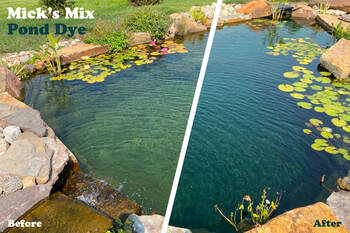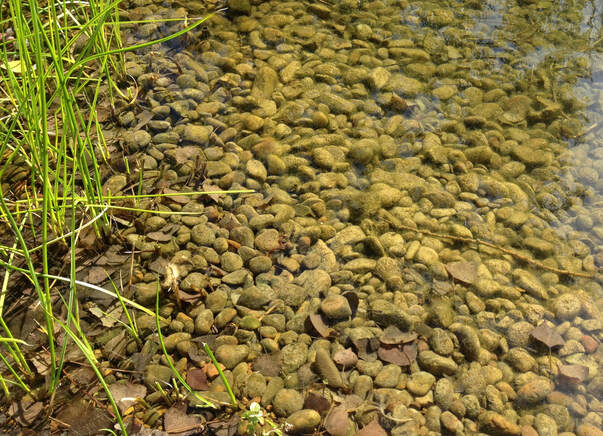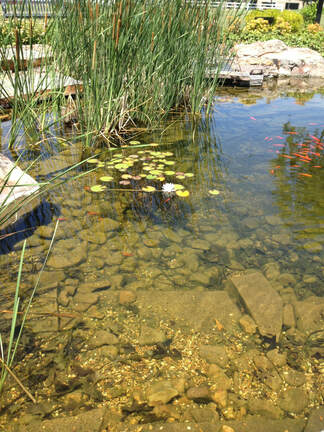Typical Natural Swimming Pool/Pond Maintenance
Typical maintenance for a Natural Swimming Pool/Pond (NSP) is more like that of a large garden pond than a traditional chlorine pool. Some maintenance is the same as a regular pool-- like emptying the skimmer when it fills up with leaves and occasionally scooping out debris/critters with a pool net-- though with a NSP, you don't have to continually monitor chemical levels and doses or regularly vacuum the walls and floor. Plus, unlike a traditional pool, which usually looks its best on day one, then starts to look dated just a few years in, the typical Natural Swimming Pool/Pond actually gets better with age and as the ecosystem balances itself often requires less maintenance overtime!
Growing the Biological Filter
There is usually more maintenance with a brand new NSP than with an older one. Think of it like a garden; you first have to plant it and grow it into maturity. Then, as your garden (or your NSP, in this case) establishes itself, your focus turns to maintaining the ecosystem. With a NSP this means that during the first swimming season or two you will keep an eye on the water quality as the biological filter is establishing itself, occasionally adding more beneficial bacteria to help strengthen the filter and pond dye to shade the water, which helps prevent string algae blooms. Occasionally, you may want to trim back your water plants or add some more varieties as time goes by (we typically recommend hardy varieties that come back each year, though there are a host of edible, medicinal and tropical water plants that you can add to your NSP). As with any pool, you will want to make sure your equipment is in working order (your pumps, skimmer, etc) and keep an eye out for any changes to your water quality (which could indicate that a pump or other piece of equipment is not working).
Growing the Biological Filter
There is usually more maintenance with a brand new NSP than with an older one. Think of it like a garden; you first have to plant it and grow it into maturity. Then, as your garden (or your NSP, in this case) establishes itself, your focus turns to maintaining the ecosystem. With a NSP this means that during the first swimming season or two you will keep an eye on the water quality as the biological filter is establishing itself, occasionally adding more beneficial bacteria to help strengthen the filter and pond dye to shade the water, which helps prevent string algae blooms. Occasionally, you may want to trim back your water plants or add some more varieties as time goes by (we typically recommend hardy varieties that come back each year, though there are a host of edible, medicinal and tropical water plants that you can add to your NSP). As with any pool, you will want to make sure your equipment is in working order (your pumps, skimmer, etc) and keep an eye out for any changes to your water quality (which could indicate that a pump or other piece of equipment is not working).

Regular Maintenance
Your automatic skimmer(s) will collect floating debris like sticks and leaves. To keep your skimmer functioning at its best, you will need to pull out and empty the net when it becomes full (depending on how many trees you have, this is usually about once a week or so). Occasionally you may want to scoop leaves and debris out of the deep end and plant area (what the skimmer hasn’t trapped for you). Though cleaning out sunken leaves and debris is helpful for eliminating excess nutrients from the water, you will notice that when a few leaves happen into your swimming pond, they aren’t an eye-sore like in a traditional white-bottomed pool. This means you don't necessarily need to regularly vacuum your NSP walls and bottom like you would a traditional chlorine pool.
Seasonal Maintenance
In most places, you will winterize the Natural Swimming Pool/Pond in the winter-- usually this is done by simply turning your variable speed water pump(s) down to their lower setting -- then you will have a yearly Spring Cleaning, which typically involves turning the pumps back up to their summer setting, emptying the mechanical skimmer net, and removing sunken debris and leaves (we recommend a pond vacuum for this and/or a leaf collection net). This is a good time to add in that extra bacteria and pond dye, as well as inspect your plumbing equipment to ensure it is in working order.
During the early spring, as water temps are just starting to rise, is when your NSP is most vulnerable to a string algae bloom. It is important to recognize the difference between string algae or filamentous algae and waterborne algae or blue/green algae. A functioning NSP (meaning, with adequate filtration and with all the equipment working) should never experience waterborne algae, which is often characterized as brown or green cloudy water (sometimes referred to as "pea soup") and can be unhealthy to swim in. A NSP in working order should have exceptional water clarity and no waterborne or blue/green algae - ever.
Though the water is clean and clear, a healthy NSP will have a biofilm or a greenish/brown living patina on surfaces underwater. This is normal and isn't an issue or sign that anything is wrong with the NSP. Though string algae is a possibility in any fresh, clear body of water, occasional blooms can be managed-- in many cases by manually pulling the algae strings out of the shallows (you can use them in composting or to fertilize your garden) or using a pond vacuum to remove algae clumps. Performing an annual Spring Cleaning can help prevent early string algae blooms as can seeding the bio filter with cold water beneficial bacteria early in the spring and shading the water with a couple teaspoons of pond dye once every couple of weeks. Planting lots of water plants (a natural competitor of filamentous algae, which is also a type of photosynthesizing plant) and stocking your pond with gold fish or other algae-eating fish will also help keep your algae amounts in balance with the rest of the pond ecosystem.
Your automatic skimmer(s) will collect floating debris like sticks and leaves. To keep your skimmer functioning at its best, you will need to pull out and empty the net when it becomes full (depending on how many trees you have, this is usually about once a week or so). Occasionally you may want to scoop leaves and debris out of the deep end and plant area (what the skimmer hasn’t trapped for you). Though cleaning out sunken leaves and debris is helpful for eliminating excess nutrients from the water, you will notice that when a few leaves happen into your swimming pond, they aren’t an eye-sore like in a traditional white-bottomed pool. This means you don't necessarily need to regularly vacuum your NSP walls and bottom like you would a traditional chlorine pool.
Seasonal Maintenance
In most places, you will winterize the Natural Swimming Pool/Pond in the winter-- usually this is done by simply turning your variable speed water pump(s) down to their lower setting -- then you will have a yearly Spring Cleaning, which typically involves turning the pumps back up to their summer setting, emptying the mechanical skimmer net, and removing sunken debris and leaves (we recommend a pond vacuum for this and/or a leaf collection net). This is a good time to add in that extra bacteria and pond dye, as well as inspect your plumbing equipment to ensure it is in working order.
During the early spring, as water temps are just starting to rise, is when your NSP is most vulnerable to a string algae bloom. It is important to recognize the difference between string algae or filamentous algae and waterborne algae or blue/green algae. A functioning NSP (meaning, with adequate filtration and with all the equipment working) should never experience waterborne algae, which is often characterized as brown or green cloudy water (sometimes referred to as "pea soup") and can be unhealthy to swim in. A NSP in working order should have exceptional water clarity and no waterborne or blue/green algae - ever.
Though the water is clean and clear, a healthy NSP will have a biofilm or a greenish/brown living patina on surfaces underwater. This is normal and isn't an issue or sign that anything is wrong with the NSP. Though string algae is a possibility in any fresh, clear body of water, occasional blooms can be managed-- in many cases by manually pulling the algae strings out of the shallows (you can use them in composting or to fertilize your garden) or using a pond vacuum to remove algae clumps. Performing an annual Spring Cleaning can help prevent early string algae blooms as can seeding the bio filter with cold water beneficial bacteria early in the spring and shading the water with a couple teaspoons of pond dye once every couple of weeks. Planting lots of water plants (a natural competitor of filamentous algae, which is also a type of photosynthesizing plant) and stocking your pond with gold fish or other algae-eating fish will also help keep your algae amounts in balance with the rest of the pond ecosystem.
What to Expect
A Natural Swimming Pool/Pond features biologically and mechanically filtered water that is free from chlorine, salt and other traditional pool chemicals. Though the water in a NSP is clean and clear, it is not a sterile, lifeless environment - it is its own natural ecosystem. A Natural Swimming Pool/Pond is a good choice for you if you enjoy swimming in lakes, streams, ponds and other natural bodies of water. If you would love to look out into your backyard and see a beautiful natural pond with refreshingly clear water (that just happens to be big enough and clean enough to swim in) then a NSP is for you! On the other hand, if you are wanting a sterile, white-bottomed, chlorine pool-like experience, then a NSP is not what you are looking for.
A Natural Swimming Pool/Pond features biologically and mechanically filtered water that is free from chlorine, salt and other traditional pool chemicals. Though the water in a NSP is clean and clear, it is not a sterile, lifeless environment - it is its own natural ecosystem. A Natural Swimming Pool/Pond is a good choice for you if you enjoy swimming in lakes, streams, ponds and other natural bodies of water. If you would love to look out into your backyard and see a beautiful natural pond with refreshingly clear water (that just happens to be big enough and clean enough to swim in) then a NSP is for you! On the other hand, if you are wanting a sterile, white-bottomed, chlorine pool-like experience, then a NSP is not what you are looking for.
Above: In a healthy, functioning Natural Swimming Pool/Pond, you will have clear water with a rocky and/or liner bottom (not muddy or silty). Though the water in a NSP is clear and clean enough for swimming, passing bathing water standards throughout the country, it is a natural body of water with a living patina (or biofilm) on surfaces underwater and with lots of other living organisms like fish, water plants, frogs and tadpoles, dragonflies, butterflies and more!



